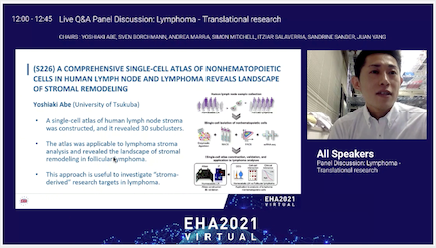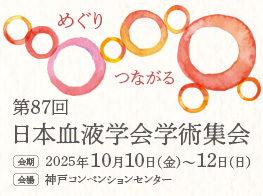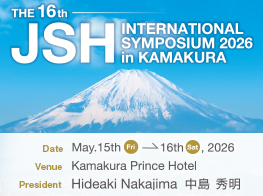
名前:安部 佳亮【筑波大学 人間総合科学研究科 疾患制御医学】
発表形式:Oral Presentation
Title:
A comprehensive single-cell atlas of nonhematopoietic cells in human lymph node and lymphoma reveals landscape of stromal remodeling
Authors:
Yoshiaki Abe1, Mamiko Sakata-Yanagimoto2,3, Manabu Fujisawa2, Hiroaki Miyoshi4, Yasuhito Suehara3, Keiichiro Hattori3, Manabu Kusakabe2,3, Tatsuhiro Sakamoto2,3, Hidekazu Nishikii2,3, Tran B. Nguyen2, Chikashi Yoshida5, Rikako Tabata6, Toshiki Terao6, Yohei Owada7, Tsuyoshi Enomoto7, Hiroko Bando8, Masahiro Nakayama9, Koichi Ohshima4, Kensuke Usuki10, Tatsuya Oda7, Kosei Matsue6, Shigeru Chiba2,3
Affiliations:
1. Department of Hematology, Graduate School of Comprehensive Human Sciences, University of Tsukuba, Tsukuba, Japan
2. Department of Hematology, Faculty of Medicine, University of Tsukuba, Tsukuba, Japan
3. Department of Hematology, University of Tsukuba Hospital, Tsukuba, Japan
4. Department of Pathology, School of Medicine, Kurume University, Kurume, Japan
5. Department of Hematology, National Hospital Organization, Mito Medical Center, Higashi Ibaraki, Japan
6. Division of Hematology/Oncology, Department of Internal Medicine, Kameda Medical Center, Kamogawa, Japan
7. Department of Gastrointestinal and Hepato-Biliary-Pancreatic Surgery, Faculty of Medicine, University of Tsukuba, Tsukuba, Japan
8. Department of Breast and Endocrine Surgery, Faculty of Medicine, University of Tsukuba, Tsukuba, Japan
9. Department of Otolaryngology, Head and Neck Surgery, University of Tsukuba, Tsukuba, Japan
10. Department of Hematology, NTT Medical Center Tokyo, Shinagawa, Japan
Abstract:
Background: Activities of nonhematopoietic cells (NHCs) in lymphoma, including mesenchymal stromal cells and endothelial cells, reportedly underlie lymphomagenesis. However, understanding of lymphoma NHC activities have been hampered by unexplained NHC heterogeneity even in normal human lymph node (LN). Particularly, human LN blood endothelial cells (BECs) and non-endothelial stromal cells (NESCs) have not been analyzed at single-cell resolution.
Aims: We aimed to complete a transcriptome atlas of human NHCs in homeostatic LN (HLN) and lymphoma to reveal previously unrecognized heterogeneity. We also sought to reveal the single-cell landscape of stromal remodeling in lymphomas, particularly in follicular lymphoma (FL), to advance understanding of stromal contributions in lymphomagenesis.
Methods: We performed single-cell RNA sequencing of NHCs (>100,000 cells) extracted from human HLN (n=9), nodal FL (n=10), peripheral T-cell lymphoma (PTCL; n=5), and diffuse large B-cell lymphoma (DLBCL; n=3) samples. Data from HLN samples was mainly used for the construction of NHC atlas. Immunofluorescence (IF) staining was performed to validate the results of single-cell analysis and to explore the topological localizations of each NHC subcluster in the LN. Using the NHC atlas, we performed comprehensive comparative analysis with FL NHCs by differentially-expressed gene (DEG) and intercellular ligand-receptor analyses. We also investigated the prognostic impact of putative stroma-derived biomarkers using deposited microarray data of FL patients.
Results: Graph-based clustering analysis revealed that the transcriptional features of NHC subpopulations in HLN are highly conserved in FL NHCs. Unsupervised sub-clustering analysis of BECs, lymphatic endothelial cells (LECs), and NESCs revealed 10, 8, and 12 subclusters, respectively, including some lacking mouse counterpart. IF staining successfully identified each NHC subcluster and its localization in the LN. In FL NHCs, the proportion of arterial BEC subclusters markedly increased relative to HLN, while the proportion of LECs decreased. In FL NESCs, the proportion of marginal reticular cells (MRCs) as well as follicular dendritic cells (FDCs) greatly increased. DEG analysis revealed that the greatest changes in gene expression occurs in NESC subclusters, particularly in MRCs, T-zone reticular cells (TRCs), perivascular stromal cells, and FDCs. Notably, in some NESC subclusters, we observed marked upregulation of genes relevant to solid cancers but previously not associated with lymphomagenesis (e.g. POSTN, EGFL6, and FAP). Combined interactome and DEG analysis revealed that interactions mediated through CXCL12 was unexpectedly upregulated only at stromal cells at adventitia. Additionally, the CCR7-CCL19 interaction was extended to non-TRC stromal cell subclusters. Also, the CXCL13-CXCR5 axis was highly activated in MRCs, indicating that MRCs as well as FDCs participate in FL expansion. Based, on these data, we identified putative stroma-derived biomarker LY6H, LOX, TDO2, and REM1 as promising prognostic predictors in FL. We finally confirmed that our NHC atlas is also useful to assess NHCs in more aggressive lymphomas including PTCL and DLBCL.
Summary/Conclusion: We constructed a comprehensive single-cell atlas of NHCs in human LN highly applicable to lymphoma NHC researches. Our study largely updates NHC taxonomy in LNs and provides a rich resource and deeper insights into lymphoma biology, a contribution that should advance lymphoma management and therapy.
The EHA2021 受賞レポート
この度はJSH Abstract Achievement Award for The EHA2021に採択を頂き誠にありがとうございました。
今回のEHAはvirtualで2021年6月9日から6月17日にかけて開催されました。私は2018年のEHAに参加して以来2回目のEHAへの参加となりました。
私はヒトのリンパ節とリンパ腫の間質細胞のシングルセルRNAシーケンス解析の結果を報告いたしました。近年特に固形癌領域において癌の微小環境細胞の役割が注目を集めており、それは免疫細胞に止まらず、血管や間葉系ストローマ細胞までもが腫瘍形成や治療抵抗性に寄与していることが報告されていますが、一方で造血器腫瘍においてはそういった解析は限定的な状況にありました。今回の研究では、シングルセルRNAシーケンスの技術を用いて、リンパ腫のヒト臨床サンプルから抽出した非血液細胞の解析を行いました。また、リンパ腫における変化を検討するために、定常状態にあるヒトリンパ節を多数回収し、ヒトリンパ節の非血液細胞の包括的なシングルセルアトラスの構築も行いました。シングルセルRNAシーケンスによる人体のアトラス作成の試みは世界的に盛んに行われていますが、サンプル回収や細胞抽出の煩雑さからヒトリンパ節の非血液細胞の大部分がこれまで未解析の状態だったので、リンパ腫の非血液細胞の解析と併せてEHAにおいて報告ができ大変光栄でした。リンパ節やリンパ腫の間質細胞の詳細なcharacterizationと比較解析を行い、今後のリンパ腫研究のベースの1つとなることを期待しています。パネルディスカッションではセッションchairやaudienceから研究デザインやlimitationなどについての質問をいただき、有意義な議論となりました。
このような貴重な機会を与えていただきました日本血液学会国際委員会・事務局の皆様に心より感謝いたします。また、日々ご指導をいただいている千葉滋教授、坂田麻実子准教授をはじめ、お世話になっている先生方、研究にご協力をいただきました各施設の先生方にこの場をお借りして感謝申し上げます。




